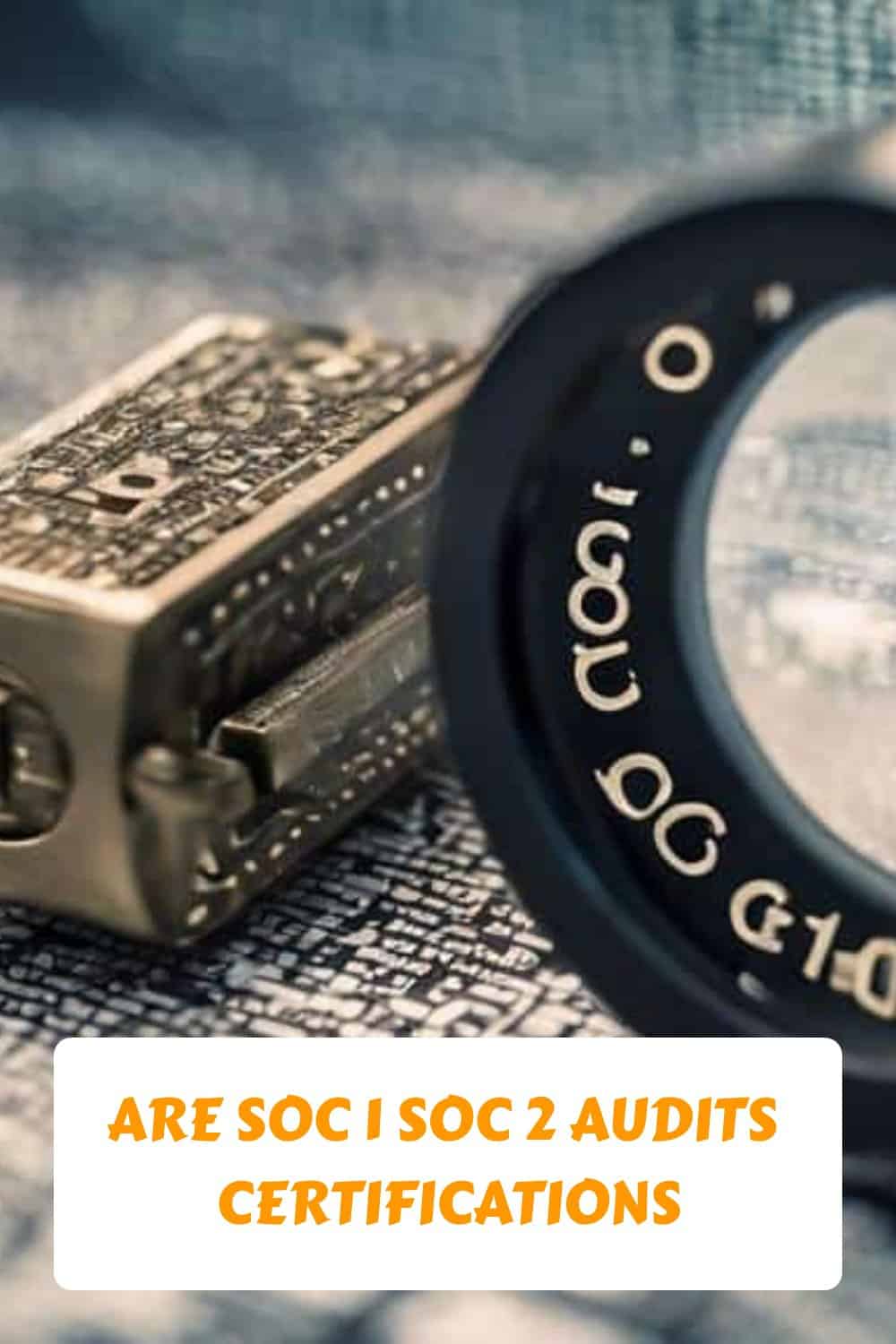You’re standing at the crossroads of compliance, where the paths of SOC 1 and SOC 2 audits diverge, yet neither leads to the land of certifications as many mistakenly believe.
These audits, pivotal for your organization’s credibility and compliance, are often cloaked in the misconception of being certifications when, in reality, they are in-depth attestations of your internal controls. This distinction is not just a matter of semantics but a crucial understanding that can shape how you present your company’s security posture to clients and stakeholders.
As you navigate this journey, consider the implications of mistaking these audits for certifications and how this misunderstanding could impact your organization’s perceived integrity.
Let’s explore the nuances that differentiate these audits from traditional certifications, setting the stage for a deeper comprehension of their true value.
Key Takeaways
- SOC 1 and SOC 2 audits are attest engagements, not certifications.
- Auditors issue a SOC report or SOC attestation report, not a certificate.
- Service organizations can use approved AICPA logos, but the report is the primary validation.
- Understanding the purpose and content of SOC reports is crucial for users.
Understanding SOC Audits
In the realm of service organizations, understanding SOC audits is crucial to ensuring your company’s controls meet the required standards set by the AICPA. You’re seeking the freedom to operate your business with confidence, knowing you’re on the right side of compliance and security.
SOC audits aren’t about boxing you in; they’re about opening doors. By undergoing a SOC examination, you’re not just ticking a box—you’re demonstrating to your clients that your organization values and upholds the highest standards in handling their data.
This isn’t about getting a certification; it’s about earning a seal of trust. With the auditor’s report in hand, you can proudly show that your services are performed with integrity and reliability, making your business a beacon of trust in a sea of uncertainty.
SSAE 18 and Attestation
Building on the foundation of understanding SOC audits, let’s explore SSAE 18 and its critical role in attestation.
SSAE 18, crafted by the Auditing Standards Board of the AICPA, sets the stage for how auditors should conduct attest engagements. You’re not getting a simple checkmark or a certificate; instead, you’re diving deep into the trustworthiness of your service organization’s controls.
This process is about showcasing your commitment to robust controls and transparency, giving your clients the confidence they crave. Auditors use standards like AT-C Section 320 for SOC 1 and AT-C 105 and AT-C 205 for SOC 2 to examine and report on your controls, providing a report that speaks volumes.
This isn’t about box-ticking; it’s about proving your mettle.
Differentiating SOC Reports
Understanding the differences between SOC 1 and SOC 2 reports is crucial for service organizations to ensure they meet the specific needs of their clients. It’s key in maintaining the freedom and flexibility your clients desire by providing the right kind of assurance about your control environment.
Here’s a quick rundown:
- Scope: SOC 1 is focused on controls relevant to financial reporting, whereas SOC 2 addresses operational and compliance controls based on Trust Services Criteria (TSC).
- Audience: SOC 1 targets users concerned with financial statements, like auditors, while SOC 2 appeals to a broader audience, including IT and compliance professionals.
- Flexibility: SOC 2 reports can be tailored to cover one or more of the TSCs, offering service organizations the freedom to align with specific client concerns or regulatory requirements.
SOC 1 Report Details
You’ll find that SOC 1 reports are specifically designed to assess the effectiveness of controls directly impacting your client’s financial statements. This means, as a service organization, you’re not just ticking boxes for the sake of compliance, you’re demonstrating a commitment to maintaining a robust control environment.
The beauty of a SOC 1 report, whether you’re looking at Type I or Type II, lies in its focus. Type I gives you a snapshot, showing your controls are in place as of a certain date. Type II, however, takes it up a notch by evaluating how these controls operate over a period, offering deeper insights.
It’s about giving your clients peace of mind, knowing their financial data is in safe hands. This isn’t just compliance; it’s about building trust and freedom from worry.
SOC 2 TSC Overview
Delving into SOC 2, it’s crucial to grasp the Trust Services Criteria (TSC) that form the backbone of these audits, focusing on controls relevant to security, availability, processing integrity, confidentiality, and privacy. You’ve got the power to choose which of these criteria are most critical to your operations, ensuring your freedom to tailor the audit to your needs.
Here’s a quick rundown:
- Security: Protecting information and systems from unauthorized access.
- Availability: Ensuring systems and information are accessible as agreed.
- Processing Integrity: Guaranteeing system processing is complete, valid, accurate, timely, and authorized.
You’re in the driver’s seat, selecting what’s best for your organization’s unique requirements, and championing your right to decide how you showcase your commitment to these principles.
Audience for SOC Reports
After exploring the critical Trust Services Criteria in SOC 2 audits, it’s essential to consider who benefits most from reviewing SOC reports. You’re in the driver’s seat when it comes to understanding the diverse audience for these reports. Imagine a diverse group of key players, each with a unique stake in the game.
| Report Type | Audience | Why They Care |
|---|---|---|
| SOC 1 | Financial Executives | Financial Integrity |
| SOC 1 | Auditors | Assurance on Controls |
| SOC 2 | IT Executives | Security & Operations |
| SOC 2 | Compliance Officers | Regulatory Compliance |
| SOC 2 | Clients & Partners | Trust in Service Reliability |
This table paints a picture of who’s who in the realm of SOC reports, highlighting the freedom to tailor insights to specific needs and interests.
SOC Examinations Explained
To fully grasp SOC examinations, it’s important to understand that they’re not certifications but detailed attest engagements focusing on a service organization’s controls.
Here’s what you need to know:
- Purpose and Scope: SOC examinations evaluate the effectiveness of controls relevant to financial reporting (SOC 1) or operations and compliance, including security and privacy (SOC 2).
- Outcome: You’ll receive a detailed report, not a certificate, showcasing your organization’s commitment to maintaining robust controls.
- Freedom to Share: You’re free to share this report with clients or stakeholders, proving your organization’s dedication to high standards without being tied down by the misconception of needing a ‘certification’.
Embrace the freedom and credibility that come with SOC examinations, setting your service apart in a crowded market.
Misconceptions About Certification
Many people mistakenly believe that undergoing a SOC examination results in a certification when in reality, it provides a comprehensive report on controls. This misconception ties down your understanding of what freedom these reports offer.
You’re not getting a badge to flaunt; you’re receiving a detailed account of your organization’s control mechanisms. This report is your tool, a means to transparently show your clients or partners how you manage and secure your processes. It’s about showcasing responsibility and building trust, not about collecting certifications like trophies.
Additional Audit Services
Beyond SOC audits, you’ll find a suite of additional services such as HIPAA, royalty audits, HITRUST, and FedRAMP that can further enhance your organization’s compliance and security posture. When you’re seeking freedom from regulatory headaches and want to assure clients of your commitment to security, consider these:
- HIPAA Compliance Audits – Navigate the complex healthcare privacy landscape with ease.
- Royalty Audits – Ensure you’re paying or receiving fair compensation for intellectual property.
- HITRUST Certification – Showcase your dedication to protecting sensitive information with a gold-standard framework.
These additional services aren’t just checkboxes for compliance; they’re your ticket to operational freedom. They demonstrate your proactive stance on privacy, security, and fairness, setting you apart in an increasingly scrutinized market.
Frequently Asked Questions
How Do SOC Audits Compare to ISO 27001 Certifications in Terms of International Recognition and Application?
You’re wondering how SOC audits stack up against ISO 27001 certifications globally. Well, ISO 27001 is recognized worldwide, offering a broader application, while SOC reports are key in the U.S., focusing more on service organizations’ controls.
What Specific Steps Should a Service Organization Take to Prepare for a Successful SOC 2 Examination?
To unlock the treasure chest of trust with clients, you’ll need to ace your SOC 2 exam. Start by thoroughly understanding the Trust Service Criteria and rigorously implementing relevant controls within your operations.
Can a Service Organization Fail a SOC Examination, and if So, What Are the Implications and Next Steps for Addressing Deficiencies?
Yes, you can fail a SOC examination if your controls don’t meet standards. The implications include potential client loss and reputational damage. You’ll need to address deficiencies and undergo another examination to prove compliance.
How Does the Cost of Undergoing a SOC 1 or SOC 2 Audit Compare to Other Types of Compliance Audits or Certifications?
You’re likely wondering how the cost of a SOC 1 or SOC 2 audit stacks up against other audits. Generally, it varies widely based on your organization’s size, complexity, and the specific services required.
What Role Do SOC Reports Play in Vendor Risk Management Programs, and How Do Organizations Use These Reports in Evaluating Potential Service Providers?
You’ll find SOC reports crucial in vetting vendors, ensuring they meet stringent standards. These audits aren’t just checkboxes; they’re your shield against risks, offering freedom from worry when selecting service providers.
Conclusion
In navigating the labyrinth of SOC audits, you’ve now equipped yourself with the map and compass needed to demystify their essence.
No longer mere buzzwords, SOC 1 and SOC 2 stand as beacons, guiding your organization through the fog of compliance and trustworthiness.
Remember, these audits aren’t shiny badges to wear; they’re solemn promises made to your clients, etched not on certificates, but through the steadfast practices of your operation.
Forge ahead, your path now illuminated by understanding and assurance.









